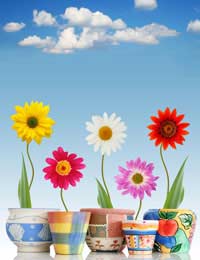Ten Ways to Recycle in the Garden and Save Money

Need to improve your garden? Don’t want to spend a penny more? Then take a look at our Low Budget Living guide to recycling in the garden and save money:
1. Container Gardening - Be Creative With Your Pots
You don’t have to spend a fortune on a plethora of pots to plant your blooms in. Just think creatively – anything with sides and a bottom can become a plant container! Whether it’s a colourful old oil drum, a row of painted tin cans, a disused sink, toilet, metal watering can, a disused wine crate (lined) or an old teapot.Just make sure that whatever you choose either already has holes in the bottom, or can have holes drilled into it. Remember that before you plant, line the bottom of your chosen container with a layer of crocks or gravel before filling with soil.
2. Make Your Own Compost and Feed!
Pet bedding (but not cat litter!), kitchen vegetable scraps, weeds, grass clippings and leaves - all the makings of a successful compost heap, and a sure-fire way to feed your garden for free.Stew nettles, comfrey or any other dark green-leaved in a bucket of water for around 6 weeks. Make sure to site well away from populated or oft-used areas, as the mixture will definitely start to pong after a while! Once ready, simply add to water a ratio of one parts stew to ten parts water, and use as a liquid feed.
3. Keep your old compost bags
If you’ve used commercially-produced compost, save the bags for later, as they have a multitude of uses. The plastic, if turned inside out, can be used as a liner for plant containers. The bags can be used time and time again as green waste bags, easy to bung in the car and to take to your local green waste recycling point.Alternatively, used compost bags with a few punch holes can be used as leaf mould bags. Simply fill with leaves, make around six to ten holes on each side, give the leaves in the bag a good soak, roll the bag opening shut and leave for around 12 months in a cool or shady place. After 12 months, you should be left with some gorgeously dark and crumbly leafmould that can be used as a soil conditioner in your garden or vegetable plot.
4. Take Cuttings
Cuttings are one of the best ways to ‘recycle’ and make your money go further. If you or a friend has a favourite flower, shrub or fruit plant, the chances are you can take a cutting and propagate an almost endless supply of your chosen plant. Take a cutting from the ‘heel’, or soft part of the plant’s stem.Some plants need little more than finely textured soil, water and a bit of warmth to establish themselves from cuttings – lavender and rosemary are two such plants that need little assistance. Others may need a little help in the guise of root growth hormone, but again, once left to their own devices, only need the occasional feed and water.








